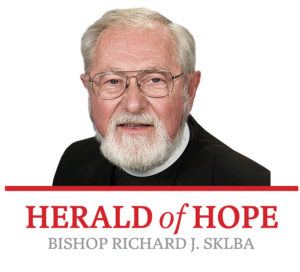BISHOP RICHARD J. SKLBA
HERALD OF HOPE
Back in 2009, Cardinal Walter Kasper, past president of the Vatican’s Secretariat for promoting  Christian Unity, wrote a fascinating and encouraging book entitled “Harvesting the Fruits.” Having shared and studied the many international ecumenical dialogues of Rome with major Christian Churches throughout the world, Cardinal Kasper was able to summarize the results accomplished over the prior half century. It is a fascinating study of all the major changes introduced into our thinking about our ecumenical neighbors over the decades since the initial days of Vatican II.
Christian Unity, wrote a fascinating and encouraging book entitled “Harvesting the Fruits.” Having shared and studied the many international ecumenical dialogues of Rome with major Christian Churches throughout the world, Cardinal Kasper was able to summarize the results accomplished over the prior half century. It is a fascinating study of all the major changes introduced into our thinking about our ecumenical neighbors over the decades since the initial days of Vatican II.
Looking out the window and checking the calendar, it’s clear that this is once again the autumn time of harvesting the grains and produce of the farms which sustain us throughout the year. At a deeper level, we also take a moment to gather the harvest from our ecumenical and interreligious conversations since Pope John XXIII’s announcement of his intention to summon a Church Council in January 1959.
There do indeed remain issues and sometimes even significant articles of belief which still separate the various Christian Churches. Serious and thorough study shows, however, that the sharp and once bitterly debated questions which tore the Church apart in the 16th century no longer need be truly “church-diving” when the smoke is cleared away and the language studied carefully. At the same time, each of the historical churches has deepened its understanding of the Christian faith and developed its creeds.
Catholics, for example, have added a conviction regarding the truth of Mary’s Immaculate Conception at the beginning of her existence and her Assumption at the end of her earthly sojourn. Many Protestant Churches have deepened and expanded their understanding of who might be called to ordained ministry as well as what the Gospel might have to say about the mystery of human sexuality. A new and different set of beliefs and practices may separate us today. They require further thoughtful conversation and new theological study.
Because of the developments of the past half century, however, we bring a fresh sense of respect for each other rather than the harsh negative condemnations of the past. The fact is that, rather than simply stating our disagreements, we approach the Lord’s Table with the understanding that we agree on 95 percent of the truths we hold in common. We are, as our Catholic Church leadership reminds us, in very real, though imperfect communion.
It’s good to keep all that in mind as we come to the anniversary of Luther’s 95 theses, allegedly nailed to a Church door in Wittenberg, Germany, on Oct. 31, slightly more than 500 years ago.
Some may still celebrate the 16th century Reformation as separation. Most, however, prefer to see those tragic events as parts of a shared effort at religious renewal according to the truth of the Gospel. A small newly installed stone monument in the front of Mary Mother of the Church Pastoral Center now celebrates 500 years of Lutheran-Catholic renewal and reconciliation. A new tree was also planted on our property similar to the memorial which was recently planted on the grounds of the Milwaukee Synod of the Evangelical Lutheran Church in America on Layton Boulevard. The trees stand as a living sign of commitment to our quest for God’s grace of reunion.
It’s a good time to take another look at Saint Pope John Paul II’s historic Encyclical on church unity, Ut Unum Sint (That they may be One), published in 1995. He invited other Churches to help him exercise his Petrine Ministry in a way which could truly promote the unity desired by Christ.
Friday, Oct. 11, 2019, marked the 57th anniversary of the opening of the Second Vatican Council in Rome. Those with expert knowledge of Church history tell us that these days it takes at least 70 years to implement a Council. Meanwhile, we work and study and pray for that gift from God’s Holy Spirit.
